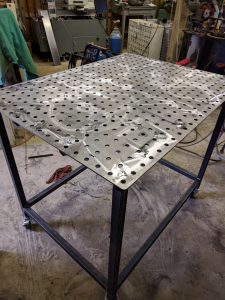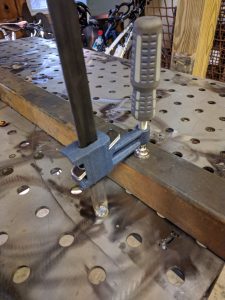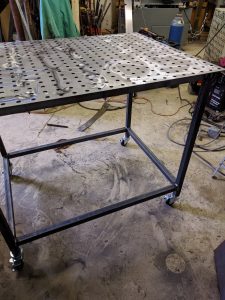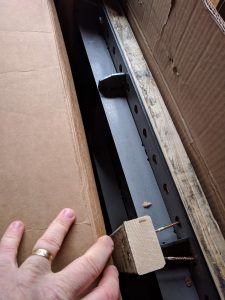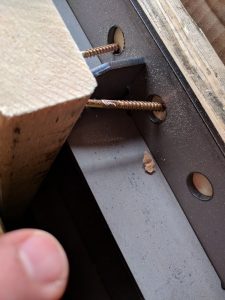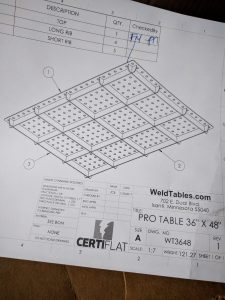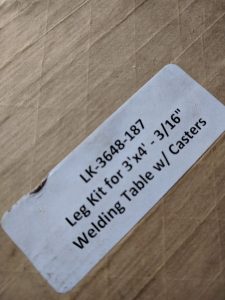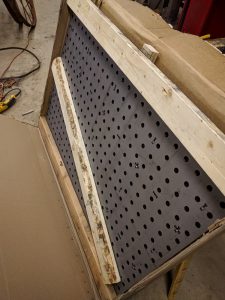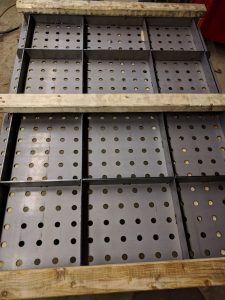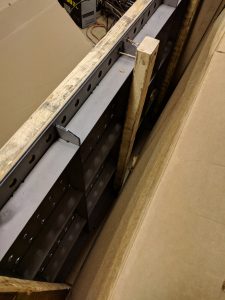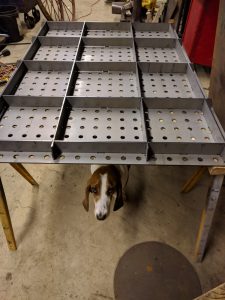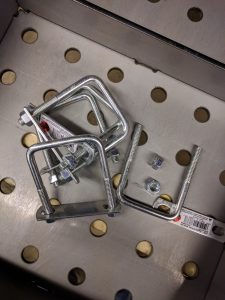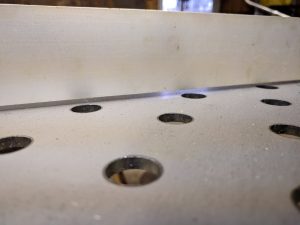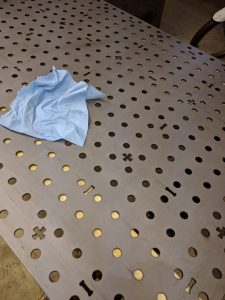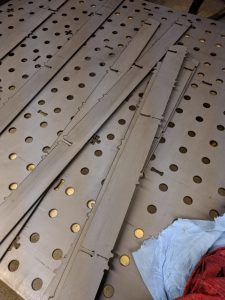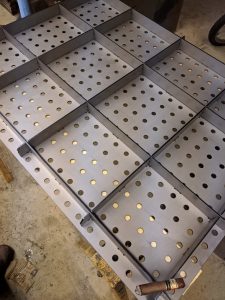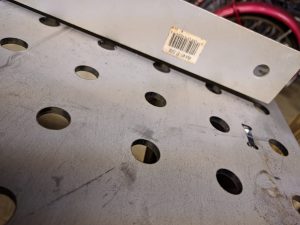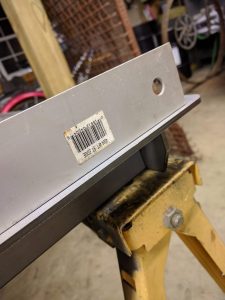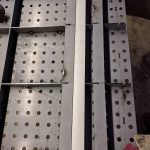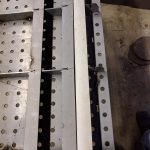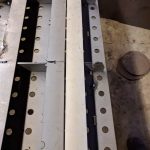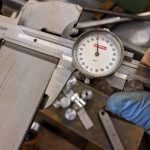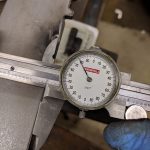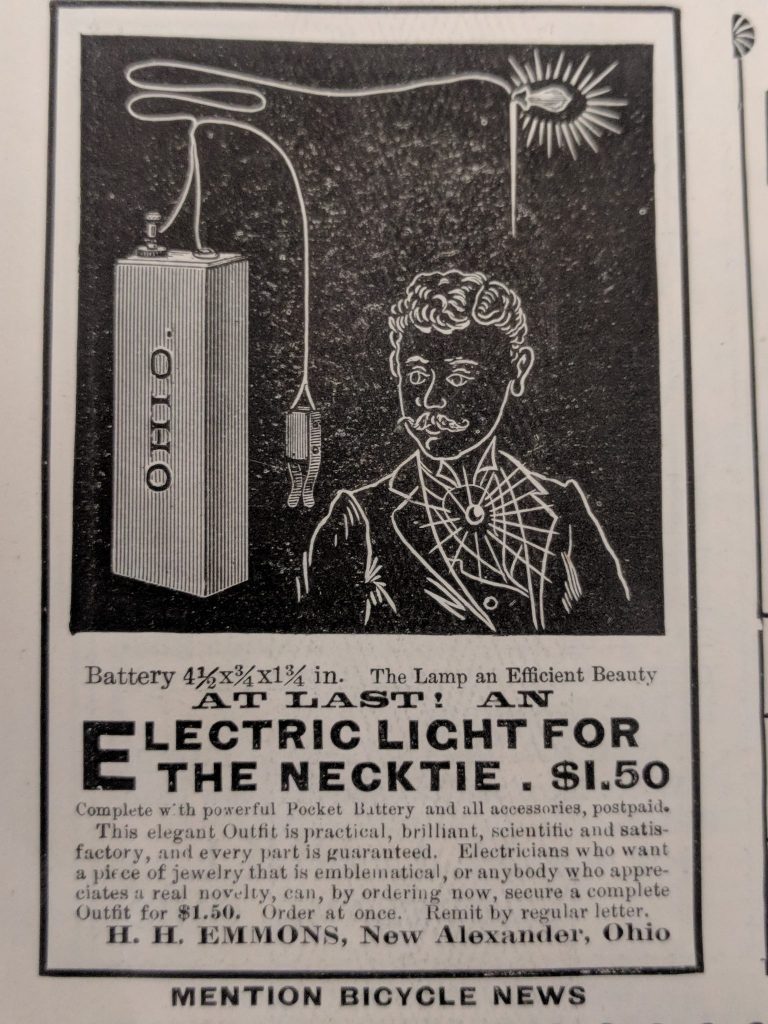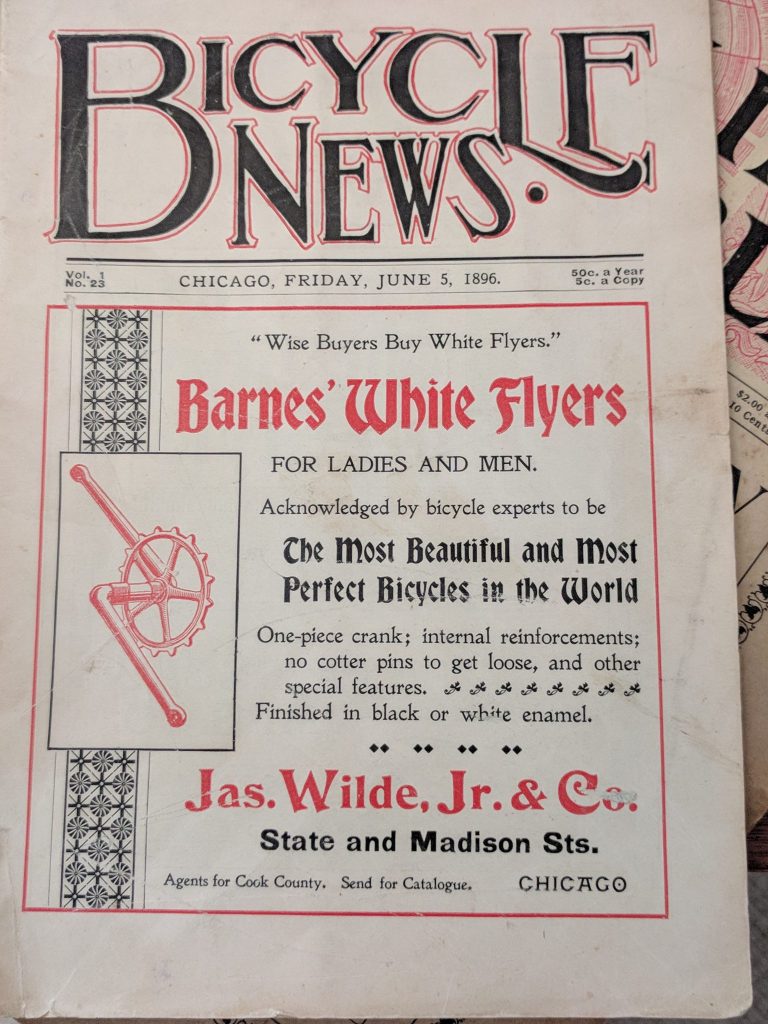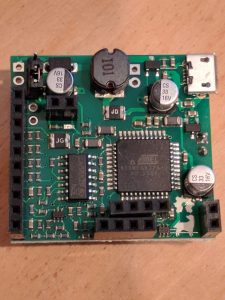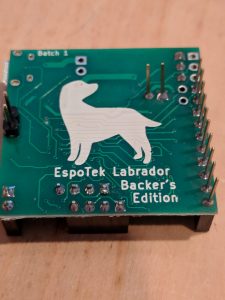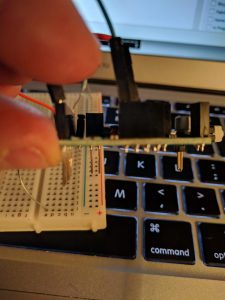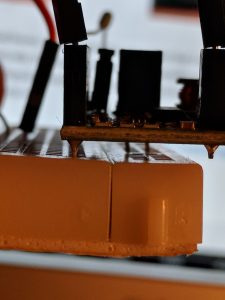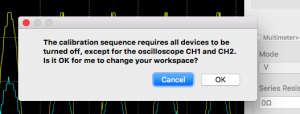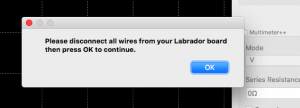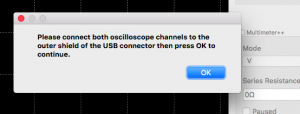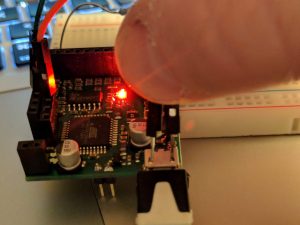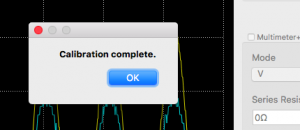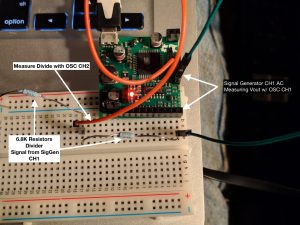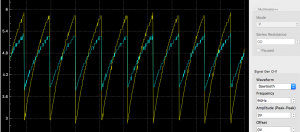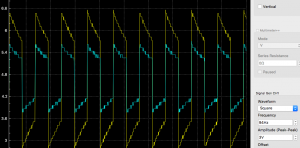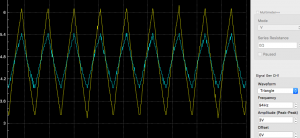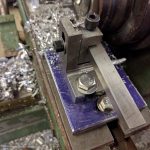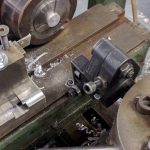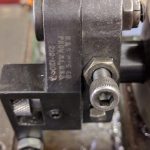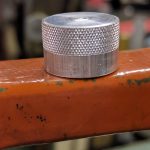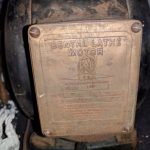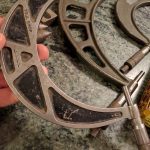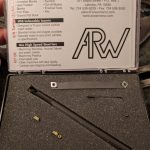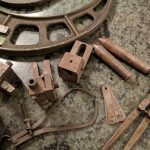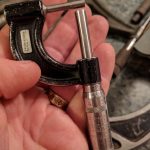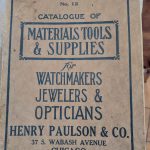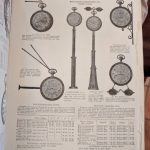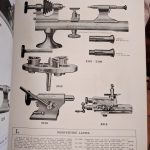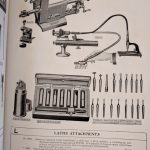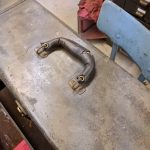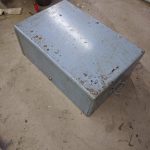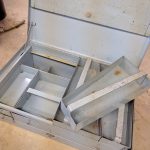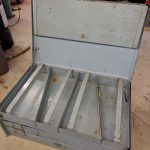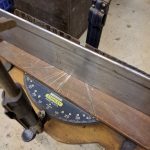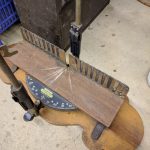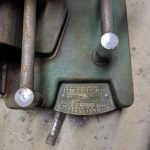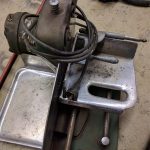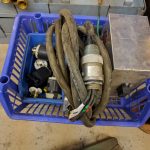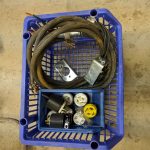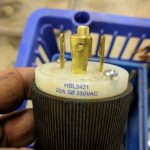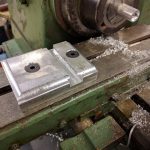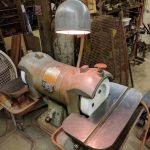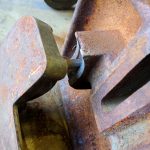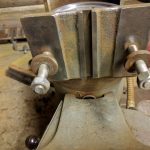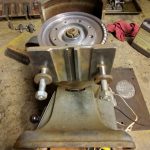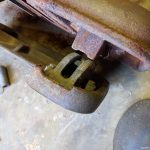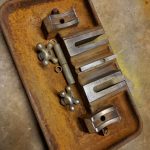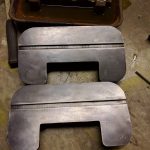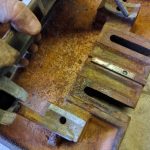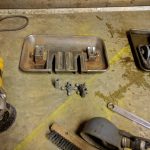All Done! Pretty happy with the final outcome of the Certiflat Welding Table kit. Took a bit of help from their support for me to get it flat but other than that pretty nice addition to the shop. Working on clamps now, I am turning down some 3/4 (don’t have any 5/8 lying around – and I have a lathe) for the pins and attaching some cheap harbor freight quick clamps to them – proto-type seems solid enough – usage over time will tell.
Certiflat Welding Table – Took the Plunge
Certiflat Welding Table
After years of working off the floor, make-shift benches and everything in between I ordered a Certiflat 36×48 Pro Top Kit. Yup, felt a bit foolish for not having built my own over the years but my work never has been traditional bench/layout work. Recently I have had been dabbling in some fab work requiring a bit more precision. So I took the plunge….I will do my best to chronicle the purchase/ship/assemble and usage of the Pro Top Table.
First: old faithful – lots of work done on this setup (well, there has been lots of these types over the year, this is the latest one)
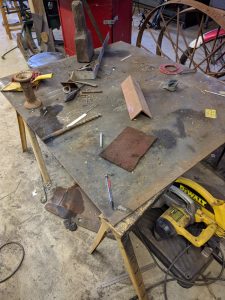
Enter weldtable.com Certiflat Pro Top Kit w/Legs (shameless referral link)
Ordering was straight forward, there follow up with referral program was quick, almost annoying but at the same time understandable. Took about 6 days until initial ship. Shipping for me was UPS and tracking was spot on. Packaging was done well, see pics below. (have seen some post where folks got damage tables)
Fresh off UPS Truck
Phone a Friend
Pretty damn heavy and very awkward to get out of box and onto saw horses. Call a friend makes easy work of that! Like I said, I have heard stories of bad packaging but this is pretty stable and had no issues.
Clean up and clamp up
Cleaned up all the pieces from left over oil and grit from the manufacturing process before clamping in place. Note, need more clamps but so far so good and all the “light tests” are looking good. Did have one troublesome rail (more light test failures than all the other parts of the table) and will take it off and double check for burrs and what not.
Tacking it up! Oh Shit!
Things have gone south at this point, sent message to the folks at weldtables.com for some assistance. I have tacked the table after removing all the gaps (no light between table and ribs) and then flipped it over to inspect for “flatness”. Straight edge on the short 3′ side was dead on when checked all the way across from one end to the other! Very excited at this point. Checking the long 4′ length is a different story. On the good end (the very edge) was real good although actually not as solid as the 3′ inspections. When checked in the middle of the table the gap was about 3/16″ and on the opposite end it was 1/4″ off — EEEK! There are not gaps against the table and ribs so I have not way to pull any bow out at this point as the table top is completely flush with the ribs. Gap pics below to give an idea what I am seeing. Hopefully the folks at weldtables let me know I did something goofy and I can fix it easily. Maybe this turns into a “don’t do it this way” tutorial.
Found what I think is the issue. I cut most of the tacks out – rookie mistake I did put a few tacks in spots that I could not easily cut. One of the longer ribs is way out of wack. Pics below. It has a bow in it and appears to be wonky with respect to width.
I assumed the ribs (as advertised) where accurate but the ones I got appear not to be so. So clamping to the ribs and removing the daylight between them and the top is no guarantee that the table is flat.
Going to request a set of rails/ribs from weldtables and go from there.
FWIW – I measured the other “good” rib in a similar fashion and they where within .003 – not off .021.
Will keep posted on weldtable response:
FLAT!
So after exchanging a few email with the folks at weldtables.com I learned the error of my ways. While I still need to look at the ribs again to understand how they work exactly I did get the table flat despite discrepancies in the ribs as pictured above. Basically clamping the untacked ribs and turning the table upright was the first step. With use of an oak board and some “heavy persuasion” I knocked out the high spots. Which basically seemed to just really tighten up the slot and tabs and maybe bring back the memory of the top. Took some moving around the table with the straightedge and some fine tuning taps but all is good and flat with the table now! More pics to follow and leg installation coming soon…
First Wearable?
Came across this advertisement in a 1896 Bicycle News . Certainly the earliest Wearable I have seen. I did dig around some other ephemera I have to see if I could spot some more but came up empty. Early 1900 Youth Companion thru 70’s Electronic Mags showed no signs of anything similar.
Espotek Labrador – Open Hardware Oscilloscope
Got my EspoTek Labrador Oscilloscope from Crowd Supply. It has been a long while since playing around with an Oscilloscope let alone an open hardware one like this. Here is my first look:
Couple of shots out of the box
Connected to a bread board: Not absolutely necessary but I would suggest starting with it. Basically fits nicely on a standard breadboard. Note, the pins for Power Supply and the Signal Generator and “Digital Outs” line up on the bread board for a pretty handy. Do take care inserting into the breadboard as they legs are pretty long and I would say not exact but they do work.
Had to dig a bit for this but found the Pinout diagram – very helpful of course. There are no pinout descriptions on the device itself or at least any legible ones for these old eyes so keep the PinOut link handy.
First, get oscilloscope software for your device at their github repo: EspoTek Labrador Releases and get it installed. I had one issue getting the device to be recognized on my MacBook Air but a simple unplug/replug in the USB cable did the trick. There may be a sequence to follow but I have not played more with is since it started working.
Have a couple of wires ready to calibrate it on startup. The basic calibration process require (appears you ground out the Oscilloscope CH1 and CH2 to the USB housing).
Next I basically recreated the sample from their wiki Tutorial: Connecting a Simple Circuit to the EspoTek Labrador
Messed around a bit with the signal generator using the same circuit: Not sure what is going on with the Square wave but the other waveforms look accurate.
All and all pretty please with the Labrador Oscilloscope. Will mess with the Multimeter and Logic Analyzer soon enough.
Rivett 918s Second Tool Post
Created adjustable sub-plate for tool posts I picked up recently at the Cabin Fever Expo. May need some additional modifications but has adequate travel to situate the form tools that I want to play with. Simple plate with slots to allow adjustment over the work piece. Don’t need much travel as the form tools will stay as close to the spindle as possible.
Tricky part of the second operation lathe is getting front and back tool post in sync. Also, depending on some of the tools I use in the turret it require sthe cross slide to be pushed up pretty close to the spindle. Hence they typically come with factory installed risers and corresponding tool post.
Rivett 918s – Added Knurling Capability
Brown and Sharpe 210-120 Knurling Swing Tool. Nice addition for the Rivett 918s. Takes 5/8″OD – 1/4ID – 1/4″ Width Knurling Wheels. Came with the “fine” diamond (male or female tbd). More wheels to come and and a bit more studying. Great document for anyone playing with knurling Reed Machinery – Knurls and Knurling has been a great help.
The swing tool is interesting. The swing allows the placement of the knurl on the part to be flexible. Single wheel limits patterns formed by multiple wheels but diamond patterns available so not a worry. Initial test shown above – not too shabby. Need to work on the push bar that contacts the swing arm, just pushed it with the cross feed plate for now.
Cabin Fever Expo – Picked up a few Gems
Cabin Fever Expo is a great place to pick up all sorts of odds and ends. The auction this year was great, the consignment area never fails to deliver and the vendors round it out with a huge variety of tools and tooling.
Cabin Fever Expo!
Some stuff for the consignment area at this years Cabin Fever Expo. Meat Slicer, Lantern Style Tool Post, Industrial Box, Kennedy Chest (a little rough), Static Phase Converter with Plugs and a Bag-o-Books.
Riser Plate for Rivett 918s
Working out a t-slot riser plate for the Rivett. With the tooling I am using in the turret it is hard if not impossible to get the cut-off tool close enough to spindle and keep the turret from running into the cross-slide. The t-slot riser plate will allow enough freedom of movement to accommodate the shorter turret tools.
I have a few Brown and Sharpe Tool Posts for Square Tools – They may be a little big but I am going to figure out a riser plate to mount these with for shits and giggles.
Walker Turner Double Carbide Grinder Rehab
Not a restoration but a good clean up of the Walker Turner Carbide Grinder. Cast iron table surfaces came out real nice, all working surfaces also cleaned up well. Put back together and added a few new AO Wheels…runs like a charm.

